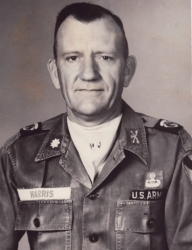
 |
|
|
||
|
Wesley Dalton Harris 'Spike' |
||||
|
Engagements: • World War II (1941 - 1945) |
||||
| Biography: | ||||
|
Wesley Dalton Harris In September 1943, then-First Lieutenant Wesley Dalton Harris was serving with Company C, 307th Airborne Engineer Battalion, 82nd Airborne Division. [After Sicily the 504th Parachute Infantry Regiment, the 376th Parachute Field Artillery Battalion and Company C, 307th Airborne Engineer Battalion were formed into the 504th Regimental Combat Team (RCT) and fought together throughout the rest of World War II.] During the night of 13 September, the 504th RCT parachuted onto the beach at Salerno into concentrated German anti-aircraft and automatic weapons fire. 1LT Harris assembled all the men he could locate and guided them through enemy territory to reach friendly troops by 1800 on 15 September, without suffering any casualties. 1LT Harris brought back accurate information about the disposition of German troops, armor, and artillery that proved of inestimable value in subsequent operations. Throughout this operation, that took place during the period 15 to 20 September, 1LT Harris personally scouted all terrain through which he moved in order to ensure his men against unexpected attack. 1LT Harris’ courageous actions and extraordinary heroism during that period earned him the U.S. Army's third highest award for valor, the Silver Star Medal. On 20 September 1944, then-Captain Harris was serving as Commanding Officer, Company C, 307th Airborne Engineer Battalion, a part of the 504th Regimental Combat Team (RCT), 82nd Airborne Division. On that day, CPT Harris’ unit was in action against German forces in Holland during Operation Market Garden. While under heavy German fire, CPT Harris personally directed the loading and movement of assault boats that enabled the 504th Parachute Infantry to successfully cross the Waal River and establish the vital Nijmegen bridgehead. CPT Harris was crossing the Waal in one of the first assault boats of the initial assault wave, under heavy German machine gun, 20 mm, and artillery fire when he was wounded in the back and arm. Despite his wounds, he continued to supervise the movement and unloading of the boats. Upon his return to the south bank of the river, CPT Harris refused medical evacuation and conducted a rapid and thorough reorganization of the remaining boats and engineer personnel for the crossing of the 2nd wave. As he led the 2nd wave, a pontoon near his boat was hit by enemy fire and capsized, but CPT Harris jumped into the river and, despite his wounds, assisted 3 men to other boats. CPT Harris then returned to the south bank and, while supervising loading of the 3rd wave, fainted from the severe loss of blood. CPT Harris' superior leadership and professional skills contributed directly to the success of the bridgehead operation. CPT Harris’ selfless, courageous actions and extraordinary heroism that day earned him the U.S. Army's second highest award for valor, the Distinguished Service Cross. During the assault by the first wave of the 504th RCT, in twenty-six assault boats while under intense fire, the unit sustained 200 casualties. Medals, Awards and Badges Distinguished Service Cross Distinguished Service Cross Citation The President of the United States of America, authorized by Act of Congress, July 9, 1918, takes pleasure in presenting the Distinguished Service Cross to Captain (Corps of Engineers) Wesley D. Harris (ASN: 0-453241), United States Army, for extraordinary heroism in connection with military operations against an armed enemy while serving as Commanding Officer, Company C, 307th Airborne Engineer Battalion, 82d Airborne Division, in action against enemy forces on 20 September 1944, in Holland. Captain Harris, while under heavy enemy fire, personally directed the loading and movement of assault boats which enabled the 504th Parachute Infantry to successfully cross the Waal River and establish the vital Nijmegen bridgehead. Crossing the river in the face of heavy enemy machine gun, 20-mm., and artillery fire in one of the first assault boats of the initial assault wave, Captain Harris was painfully wounded in the back and arm but continued to supervise the movement and unloading of the boats. After returning to the south bank of the river he refused medical evacuation but effected rapid and thorough reorganization of the remaining boats and engineer personnel for the crossing of the second wave. While leading the second wave a pontoon near his boat was hit by enemy fire and capsized, but Captain Harris plunged into the river and despite his wounded condition assisted 3 men to other boats. Captain Harris then returned to the south bank and while supervising loading of the third wave, fainted for the loss of blood. Captain Harris' intrepid direction, heroic leadership, and superior professional ability contributed directly to the success of the bridgehead operation and were in keeping with the highest traditions and standards of the United States Army. General Orders: Headquarters, XVIII Airborne Corps, General Orders No. 8 (November 14, 1944) Death and Burial Lieutenant Colonel Wesley Dalton Harris died on 5 September 1962 in Lovington, Lea County, NM. He is buried at Resthaven Cemetery in Lovington, Lea County, NM. https://www.findagrave.com/cgi-bin/fg.cgi?page=gr&GRid=13313253 |
||||
| Honoree ID: 313610 | Created by: MHOH | |||
Ribbons
Medals
Badges
Honoree Photos
 |  |  |
 |  |
 |


